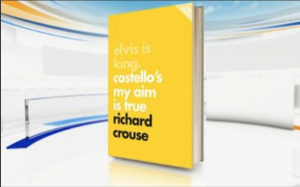“Elvis is King” according to “Be Stiff: The Stiff Records Story” author
 By Richard Balls (author of Be Stiff: The Stiff Records Story and Ian Dury: Sex & Drugs & Rock ‘N’ Roll)
By Richard Balls (author of Be Stiff: The Stiff Records Story and Ian Dury: Sex & Drugs & Rock ‘N’ Roll)
My Aim Is True has the strongest single identity of any of the albums contained in the pantheon of Elvis Costello’s work. It is also the most iconic. So Richard Crouse’s look at both the record and the inchoate, pre-Attractions Costello is a welcome addition to any fan’s bookshelf.
Crouse followed his hero’s progress from afar – Liverpool, Nova Scotia, in fact – after identifying the bespectacled singer on the other side of the Atlantic as someone who was “making music that spoke to me”. Fortunately, his pocket-sized book (just 118 pages) is no hagiography and far more instructive than a song-by-song dissection of the record he got his older brother to bring home for him.
Costello’s early musical influences were as diverse as the records he would go on to make, from The Siamese Cat Song by Peggy Lee, which as a toddler he demanded that his mum play, through to The Beatles, The Supremes and Gram Parsons. He was only 16 when he got up to play in public for the first time in the crypt of a church in Richmond, and by all accounts it did not go well. However, a move from London to Liverpool saw him develop a taste for American country-flavoured rock and the kind of groups that were inspiring groups to venture out into pub back rooms. He and his friends followed suit.
This scene-setting is vital as it explains why, as punk was frothing at the mouth, an agitating young singer was recording a country-tinged album with a Californian bar band. At this point The Attractions hadn’t been hired, and it was with Clover that he recorded his debut at Pathway Studios.
There is, rightly, much emphasis on Dave Robinson and Jake Riviera’s maverick label Stiff Records, in whose scruffy offices the transformation from computer-operating geek to cool new waver began. It was Stiff’s keen understanding of promotion and marketing stunts that helped launch such a difficult-to-market artist. His arrest for busking outside the Hilton Hotel in London where CBS executives were holding a conference resulted to him being signed and MAIT being released in the US.
Fan or not, he doesn’t shy away from aspects of the Costello’s early career that some found off-putting. The labelling of some of Costello’s anti-romance songs as misogynist is, says Crouse, “a fair charge”, while the abrasiveness he cultivated on-stage and press interviews is chronicled in a chapter headed Prince Charmless. On stage he could be no less prickly. “I see we’ve got some cunts in the audience tonight,” he snarled during the Stiff tour of 1977 on which he deliberately played songs no one knew.
There are no original interviews with Costello or any of the musicians involved in MAIT, Crouse instead getting the thoughts of a host of other writers. Nor are there any images in this latest in the pop classics series. But fans will find plenty to feast on in a book that documents a seminal record and the arrival of one of the most gifted songwriters of his generation.
